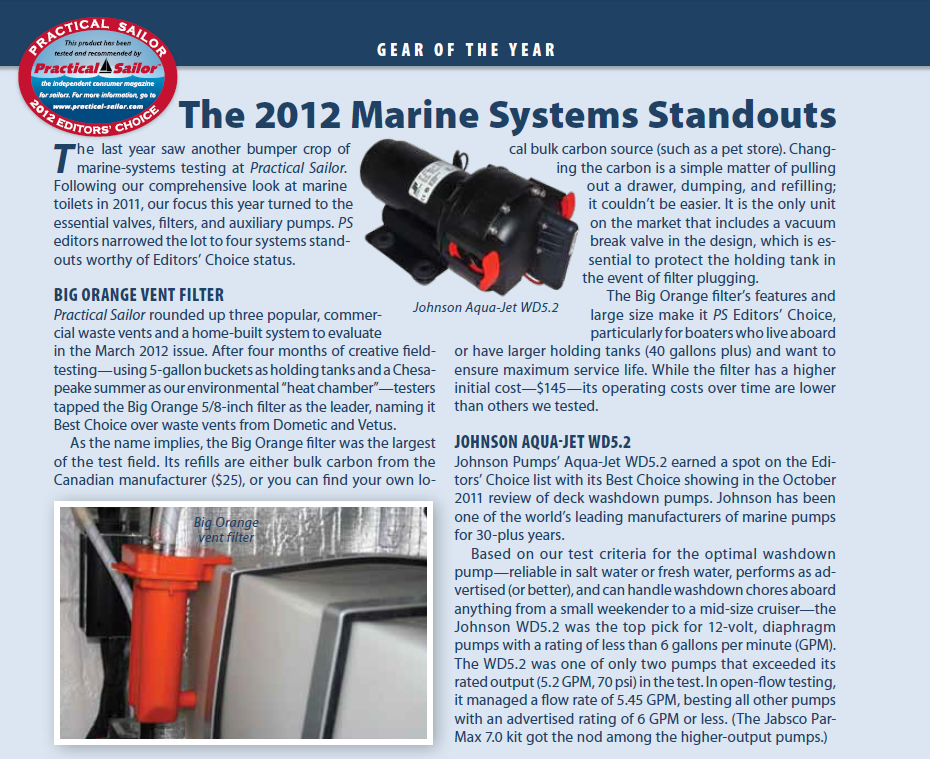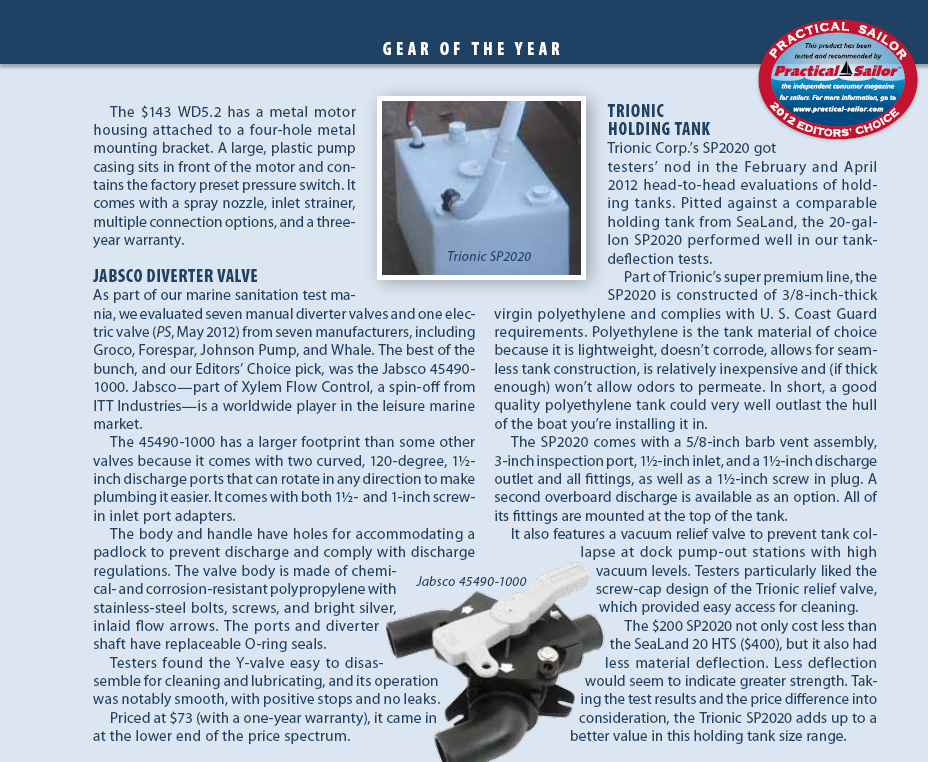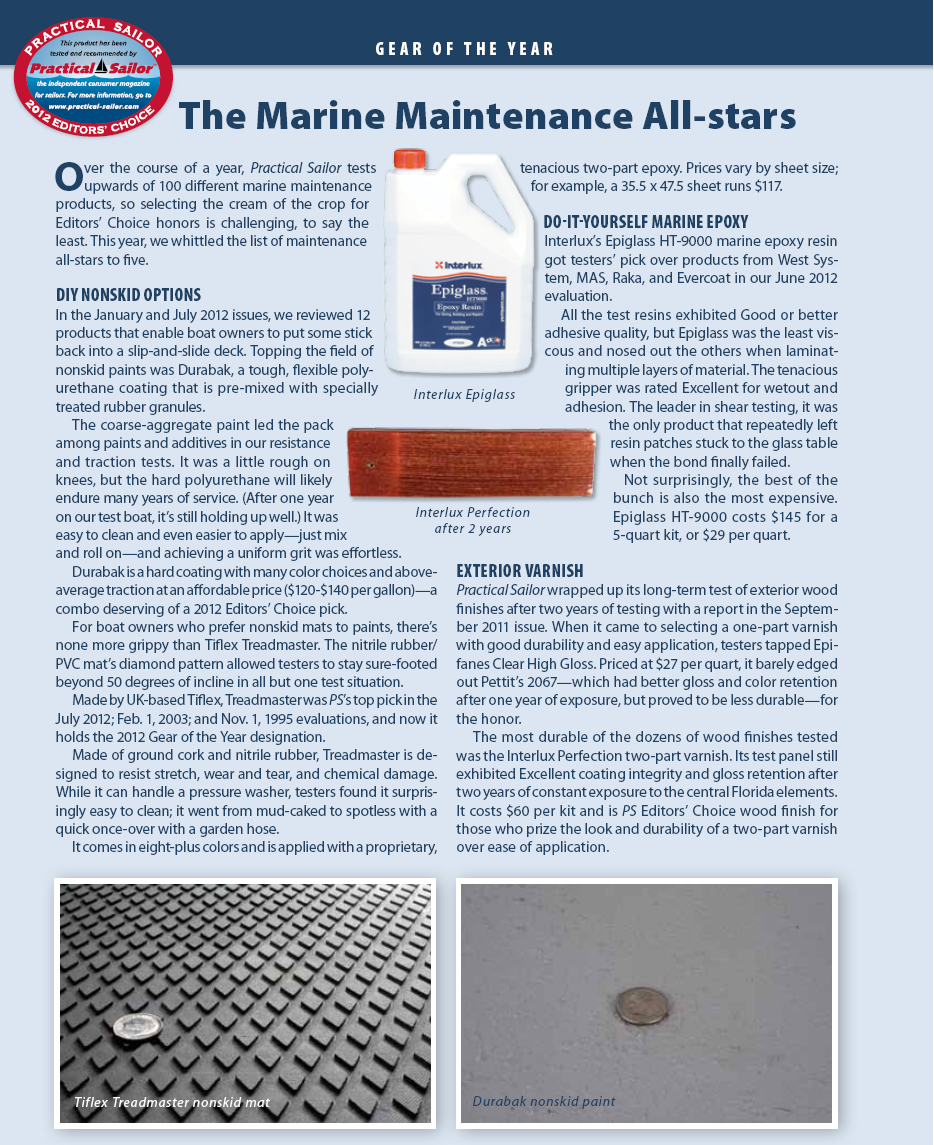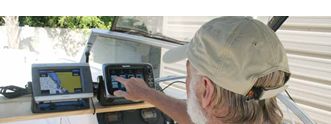
A hybrid touchscreen multi-function display that can link with your iPhone; an iPad app that can serve as a backup for your chartplotter; a powerful, rechargeable LED spotlight that floats; an affordable vent filter that eats up holding tank odor; and a single-part varnish that retains a mirror-like gloss for more than a year-these are just some of the products that drew the highest praise from Practical Sailors editors in 2012.
Of the dozens and dozens of marine products we tested between September 2011 and August 2012, only 18 earned the designation as 2012 Editors Choice gear. These are products that clearly stood out among their peers during our independent tests as the best in their category and whose performance earned the confidence of Practical Sailors editors. Many of this years Editors Choice products fell in the upper range of the price spectrum, but there were also some priced well below their peers. (Sailors looking for Budget Buys-the most affordable recommended product in each category-should refer to the individual test reports.)
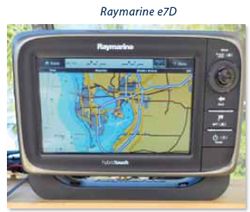
Raymarine e7D
Made by marine electronics giant Raymarine, the Ray e7D chartplotter-sounder, with its 7-inch screen, is the smallest and newest of Raymarines networked multi-functions displays (MFDs), but it is loaded with many of the features that the larger units boast.
Practical Sailor evaluated the e7D in the July 2012 issue, comparing it to the Garmin 740s (a top performer in our review of compact plotter-sounders, which was published in the November 2011 issue). Both products excelled in tests, earning across-the-board Excellent ratings, but what sets the e7D apart is its expanded networking options and its long laundry list of new-to-the-marine-market capabilities like WiFi and Bluetooth interfaces to mobile computing devices such as iPads and iPhones. The e7D is capable of working as a standalone unit or being fully networked with other members of the new Raymarine chartplotter family and the C and E-series widescreen units.
The e7D is a hybrid touchscreen unit that combines tactile knobs and buttons with touchscreen functionality.
The e7D comes with a Navionics USA Raymarine microSD map chip that offers the Navionics Silver charting package. It uses micro SD memory cards and has two slots to accommodate them. Testers noted chart detail and presentation in the 2D chart view was clear, and in the 3D view, it was the sharpest of the bunch.
Measuring approximately 9 x 6 x 3 inches, the e7D has an internal GPS antenna and a 48-channel, WAAS-capable GPS receiver. It can interface with radar, NMEA 2000/0183-capable devices, and AIS. It draws 1.09 amps and is rated as IPX6 water resistant.
The Ray e7D comes with a three-year warranty and costs $1,600-$1,700 (about the same as the Garmin); a sailboat transducer will run another $100-$445.
The e7Ds networking options and features like WiFi and Bluetooth interfaces earned it a spot on this years Editors Choice roster. If you like bells and whistles, then this is the obvious choice.
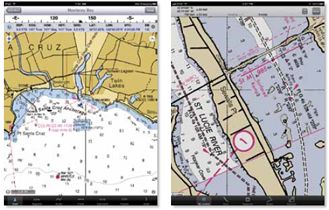
iNavX & iSailGPS
In 2012, Practical Sailor checked out dozens of iPad applications geared toward sailors and boaters. We tested top-tier navigation apps (PS, February 2012), budget chartplotting apps (PS, March 2012), and miscellaneous apps for things like weather, tides, and boosting your pirate vocabulary (PS, April 2012). Testers top picks were the iNavX navigation app and the iSailGPS chartplotting app. Both impressed us enough to earn Editors Choice honors.
iNavX bested more than 14 other well-established iPad navigation apps we tested, including iPad Navionics and Charts & Tides. While its a bit pricey compared to most mainstream apps ($50 for NOAA RNC global; prices for other versions vary), iNavX is the original and still one of the best navigation apps for the iPad.
It operates similar to a high-end dedicated chartplotter, but it does not come with charts. Users can easily download into the iPads memory any or all of the NOAA raster charts for free, and updating is easy. For those who prefer vector, iNavX can do that, too.
Navigating with iNavX is straightforward, and anyone with experience using a GPS, Loran, or chartplotter will be immediately competent. Users begin by choosing a chart area (e.g. NOAA East Coast); the software will open the chart where you are located; and youre navigating.
About the only thing you cannot do is overlay radar images or open multiple windows to show a fish-finder or video cam. You can get other NMEA feeds (apparent/true wind, autopilot, etc.), but you need to set up a WiFi system on your boat.
Testers noted that iNavX is designed as well as and is more user-friendly than most chartplotters weve seen. It earned Excellent ratings for stability, features such as satellite-image overlay and marina information, and pan/scroll speed using vector charts. The extremely intuitive, simple app concentrates on the essentials and does it well.
For those looking for a more basic and budget-friendly chartplotting app for iPad, theres the $7.99 iSailGPS by James Associates.
Testers rated iSailGPS Excellent overall. It uses NOAA raster charts and has several distinct advantages over its nearest competitors, eSeaChart and Simple Charts, including the capability to create and edit waypoints and routes. It also has an excellent built-in help guide and more help on the developers website; testers found this to be the best combination of text and screenshots among all the low-priced apps.
In basic navigating functions, this straightforward iPad app is the best of the low-priced options.
Both iSailGPS and iNavX enable the iPad to function similar to a regular chartplotter; however, we don’t recommend using an iPad as your sole navigating tool. It and the apps will serve best as auxiliary or backup nav tools.
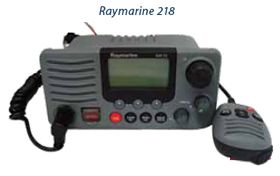
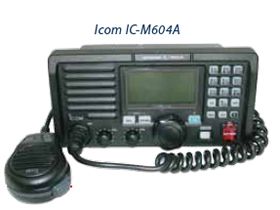
Icom IC-M604A & Ray 218
Two high-end marine VHF radios that PS reported on in the July 2012 issue earned their place among this years Editors Choice picks: the Icom IC-M604A and the Raymarine 218.
These fixed VHFs go way beyond the basic capabilities of moderately priced units. Both are NMEA 0183 network compatible, have 30-watt hailers, and are remote-mic capable. They also are submersible, feature microphone handsets with various control options (from channel changing to channel scanning), come with three-year warranties, and have Digital Selective Calling (DSC) functionality.
Icoms most sophisticated marine VHF radio, the IC-M604A, features an alphanumeric keypad, large display, and a $512 price tag, making it the second most expensive test radio. The only test unit with a keypad, the M604A also had the largest footprint (4.34 x 8.65 x 4.31 inches) and a detachable mic. When interfaced with a compatible GPS, the M604A will display time and position data, boat course, and boat speed.
Its transmit power stability was rated Good, while frequency stability and receiver sensitivity were Excellent. Audio quality was also top notch, with one of the loudest outputs at 97 decibels.
With very good overall performance, a keypad, and numerous other user-friendly features, the IC-M604A earned a 2012 Editors Choice award.
The Raymarine 218 also offers a host of useful features, including a moderately sized display (2 5/8 x 1 3/8 inches) and a mount-anywhere microphone option. It can also connect to an optional remote mic to be operated as part of an intercom system. However, it does not have a keypad.
Performance-wise, the $456 Ray 218 was outstanding. Testers found the 218s power output over the tested temperature and voltage ranges to be Excellent. Frequency stability and audio quality also were rated Excellent, while receiver sensitivity was Good. It measured 89 decibels for audio output.
The 218s phonebook will store up to 50 Maritime Mobile Service Identity (MMSI) numbers, and when its interfaced with a GPS, the 218 displays time, boat position, course, and speed.
Buyers who want the convenience of a keypad should go with the IC-M604A; those who don’t can save roughly $83 by going with the Ray 218.
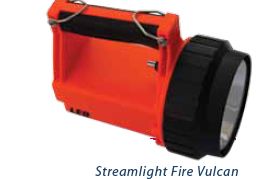
Streamlight Fire Vulcan
In the January 2012 issue, we evaluated seven LED spotlights priced between $50 and $150 from West Marine, Sirius, Coleman, Brinkmann, and Streamlight. Testers top pick in that test was the Fire Vulcan made by Streamlight, a company that provides lights for the military and police and fire departments. The 2012 Editors Choice awardee scored big points for its sheer ruggedness and versatility.
Powered by two lightweight, rechargeable lithium-ion batteries, the Fire Vulcan LED 44450 is shaped like a slender brick with a handle on top. At 1.8 pounds, it is much lighter and more ergonomic than any of the other rechargeable spotlights tested. It also was the only test light rated at IPX7 water resistance (1 meter immersion, 30 minutes), and it floats-beam up.
The Fire Vulcan has one C4 primary LED plus two very bright blue LEDs that shine rearward in a continuous or strobe pattern. Its three-way switch allows either of the two forward-firing power settings to include the rear-facing LEDs. Its selectable low and high beams are operated by a simple bat switch that can easily be operated while wearing heavy gloves. The Fire Vulcans base allows it to sit on a flat surface with the handle up, and its charger rack (powered by 12-volt or 120-volt) is designed to be wall-mounted.
Testers looked at the spotlights construction, battery life, beam angle, and illumination at both close (740 lux at 30 feet) and distant (one-fifth of a mile) targets. The handy and compact Fire Vulcan LED rated Excellent for beam pattern and illuminance at one-fifth of a mile, and it developed little heat. It lasted for 2 hours before dropping to half-strength. Its ruggedness, along with its waterproof rating, make it a good choice for cruising.
With the $120-$146 Fire Vulcan, you get what you pay for, including a seven-year warranty that bested any other makers offer.
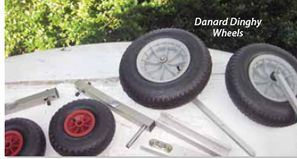
Danard Dinghy Launcher
Wheeled dinghy launchers-like our Editors Choice pick, the Danard Marine Launching Wheels (DW-1)-can give you the mechanical advantage you need to get your dinghy or small boat to the dock or ramp, or even across a beach.
The DW-1 was the hands-down Best Choice among the seven dinghy launchers we evaluated (PS, October 2011) from Davis Instruments, Garelick, Newport Vessels, Defender Industries, and Danard. We tested each dinghy roller on three different terrains-flat concrete, a rocky shore, and a soft, sandy beach-and testers also considered ease of use and ease of installation.
A glance at the components tells plenty about the top quality of the Danard wheels: precision-machined, anodized-aluminum transom brackets and wheel struts, 16-inch Butyl tire tubes (rather than less-expensive natural rubber), and a brass, angled air fill to reduce wear to the stem. The DW-1 also doesn’t require cotter or clevis pins for raising or lowering; instead, the system relies on gravity and buoyancy to hold the struts in place inside the channeled transom brackets.
The Danard launcher, with a 350-pound capacity, was the only test product to earn across-the-board Excellent ratings as it can handle just about any kind of terrain.
At $245, the Danard DW-1 also was the most expensive dinghy-launching system we tested, but not by much, and it is the only one that comes with a lifetime warranty. Its superior construction quality, ease of use, innovation, and warranty earned it the Editors Choice award.
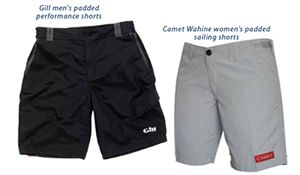
Gill & camet sailing shorts
Practical Sailor editors chose a his and a hers pick for the apparel Editors Choice: the Gill mens performance padded shorts and the Camet Wahine womens sailing shorts.
Our tests of padded sailing shorts, reported in the March and June 2012 issues, included products from top sailing apparel makers-Helly Hansen, Harken, Gill, Sailing Angles, Henri Lloyd, Zhik, and Camet International. We put the test shorts through a series of bench tests emulating a few seasons of active wear onboard a sailboat. The tests were designed to evaluate ruggedness and durability, comfort, ease of use (inserting foam pads), drying time, odor resistance, color retention, and any tendency for the fabric to shrink. Each pair also was evaluated on its features, including pockets, zippers, Velcro closures, fasteners, stitching, and the quality of material and construction.
The Gill mens shorts edged out the Camet Rio mens shorts to get testers top pick. Described as fashionable and functional, the lightweight and fast-drying Gill shorts can accommodate closed-cell foam inserts (in two interior rear pockets with Velcro closures) and are made of soft Nylon Tactel fabric with a water-repellent finish. According to Gill, internal pad pockets are better for hiking out and make the shorts more versatile for wear off the boat (without pads). The pads are imprinted with dotted cutting lines to help guide trimming for a customized fit.
The Gill shorts also feature belt loops, elastic comfort stretch bands on both sides of the waist, a sturdy zipper, and a button closure. They have two open slash pockets and a third front cargo pocket on the left thigh; the latter with a Velcro closure and weather flap.
Priced at $89, the Gill shorts rated Excellent on all test points, except abrasion resistance, in which they earned a Good rating due to some abrasion to thinner areas of the shorts.
The womens Camet Wahine shorts are lightweight and designed with a womans figure in mind. The shorts are low rise with an 8-inch inseam, and they have a flat front with pockets that lay flat. The fast-drying fabric is lightweight nylon with a durable water-repellent finish that offers UV protection (UPF 40+). Made in the USA, the shorts feature belt loops, a somewhat small dipper pocket, and a button closure.
The seat is reinforced with Cordura, which passed the abrasion test without significant wear. The seat pad is inserted into a pouch sewn on the outside of the seat. Slightly stiff, the pads lend an ungainly overall look that can be tamed by trimming the pads to fit.
The $75 Camet Wahines earned a spot on the Editors Choice roster as they are tailored specifically for female bodies and they held up well during bench and field tests.
